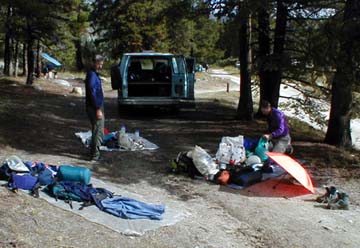
Packing at the roads end. Click image to enlarge.
Cirque of the Towers
I have always wanted to visit the legendary climbing in the Cirque of the towers in the Wind River Mountains of Wyoming home of two of the 50 classic climbs: Wolf's head and Pingora. But, all of my climbing buddies had already been there and did not want to return. This year however John Yates was interested in climbing half of the fifty classics which meant that he wanted to climb the classic route on Pingora. After decades of work we were finally able to persuade Hal to return to the Cirque.
A muddy welcome
In the summer of 2000 the Wind Rivers experienced 2 months of dry sunny drought conditions. That ended with our arrival. the roads into the trailhead were wet and muddy. John's truck slithered off the road on one hill and ended up in a muddy ditch. Luckily other climbers came along and used their four wheel drive truck to drag us out of the ditch. After that, John put on his chains and we managed to get in to the trailhead. The moral of this part of the story is if you are driving to the Cirque of the Towers have four wheel drive, mud and snow tires or chains.
Heavy packs
After a rainy night and morning the sun peaked out and we rushed to pack our gear for a 5 day trip into the cirque. We each spread out a tarp and put everything out where we could see it, then stuffed it into our packs.

Late in the morning we were ready to leave. Our packs weighed in at 50 pounds. that included 10 pounds of climbing gear, each. John had convinced me to lead on twin 8 mm ropes. Each of them weighed 6 pounds making them half the weight of a single 11 mm climbing rope. It is scary to look at such a thin rope and think of trusting your life to it, but they sure are light, and I know that while single ropes have been cut during climbing falls, twin ropes have never failed.
As we hiked, the clouds built up into towering, dark, cumulus. Below Jackass pass, a wall of rain rushed up the canyon toward us. I noticed a small meadow ahead and pointed it out to Hal and John. We hustled to the meadow then quickly put up John's ten. The timing was right, just before the skies opened, we jumped into the tent. What a great idea! We waited out the rainstorm in dry comfort. After two hours the rain stopped, we put away the tent and continued up the trail toward the Cirque.
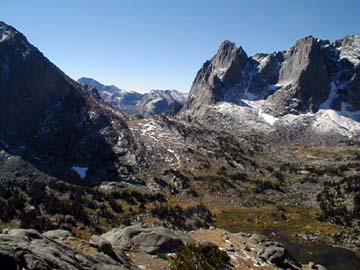
We crossed Jackass pass and set up camp on a flat grassy spot in the bedrock rib that splits the center of the pass. Camping is illegal within a quarter mile of the lake in the center of the cirque. Four other tents filled the upper meadows in the center right of the photo.
Blizzard
We started to eat dinner in a wee mist so we sheltered under a boulder. After we had eaten our raman noodle soup and added boiling water to our freeze dry dinner there was a flash of lightning followed within a second by thunder. We all knew that it was not good to shelter under a boulder in a lightning storm so we grabbed our gear and headed for the tent. Just as we reached the tent a deluge of rain began. We sat back and thought about dinner: I looked at Hal, Hal looked at John, John looked at me. No one had brought the dinner to the tent. We listened to the rain pound on the tent and no one volunteered to go out and get the dinner. After two hours the sound of the rain stopped. I volunteered to get the dinner. John just smiled and poked the roof of the tent. there was the hissing sound of snow sliding off the roof and then the pounding of snow onto the tent resumed. I retracted my offer to get dinner. we all slid off to sleep without the benefit of evening calories.
In the morning we looked out and were greeted with a picture postcard view of mountains draped in snow. We debated whether we should stay or leave. In the end we decided to stay and see what would happen.
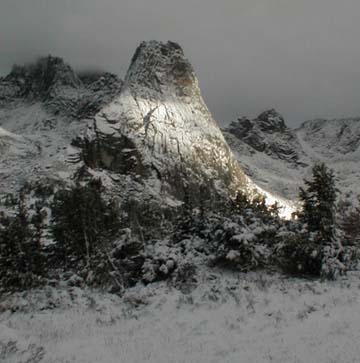
As the morning progressed and blue sky began to appear it seemed like staying was the right decision. The breaking clouds and sun over Warbonnet peak gave us hope.
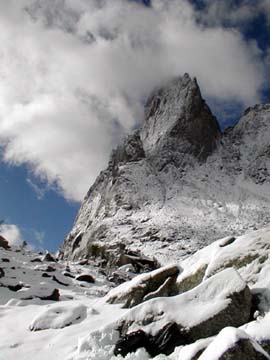
When we looked out of our tent a day later we could see that there was still snow and clouds but we decided to try to climb the south buttress of Pingora a 4 pitch, 5.6.
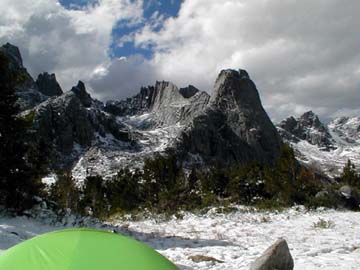
Climbing
We got an early start and soon were hiking up the west side of the buttress. Behind us we could see a group of 11 from Prescott College. They obviously knew the approach better than we did, so while we climbed up to the crest of the ridge they stayed low and climbed up at the last minute. We had just enough of a lead and beat them to the route by 15 feet! Whew that was close. I ran up the first pitch with its two fourth class rock steps, I climbed fast and placed no pro on the 4'th class pitch. Then I came to the start of the 5.6 cracks. I slowed down a bit to place protection in the welcoming cracks. The rock was beautiful solid granite, and the snow was all gone. We were first on the mountain. What a great day!

The climb goes up the large corner just right of the center of the buttress, which appears in shadow above. (An alternate 5.7 version of the climb goes up the corner which appears as a smaller shadow, nearer the center.) John Yates lead this 5.6 corner.
Above the corner were the K cracks. The guidebook calls the left K crack excellent 5.8, well protected and steep on good rock. I volunteered to lead it as soon as I saw it. Hal however spoke up and said that it was his turn to lead and he was going to follow the classic 5.6 route. After Hal's lead we scrambled over snowy ledges to the summit. Where we rested and enjoyed the great view of the Cirque and Wolf's Head.
Descent is made by rappelling from fixed anchors just to the west of the regular route. As we descended we could see that we were far ahead of the climbing parties from Prescott. Even though we had taken just under an hour a pitch. We all knew that our climbing speed was far too slow to tackle the 10 pitches of the 5.8+ classic route on the east face. We also guessed that the North facing pitches on Wolf's head would be snowy and icy. So the next day we opted to climb Bollinger peak via its 3rd class North face instead.
The next day was beautiful. We climbed Skunk Knob in the center of the Cirque and got a fine view of the classic routes on Pingora and Wolf's head.
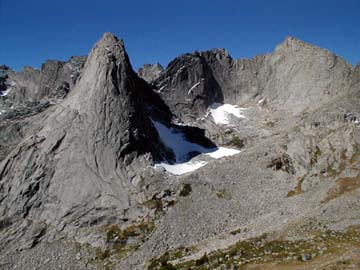
We scrambled up the talus to the north face of Bollinger and looked up in horror at the snow and verglass covered slabs. We decided to see how far we could get up the steep snowy 3rd class route, but in under an hour we were stopped by dangerous icy slabs and turned around. We don't often get our asses kicked by 3rd class routes! I'm glad we didn't try Wolf's Head.

The fifth day we hiked out in good weather. We were out of food. On the way out we saw a fresh bear print in the hiking trail. We were glad to know that there are no grizzlies in this part of Wyoming, yet.
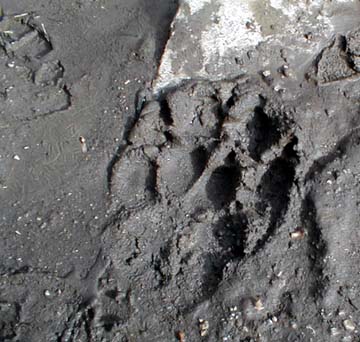
We also saw a weird cloud shaped like the Greek letter Omega.
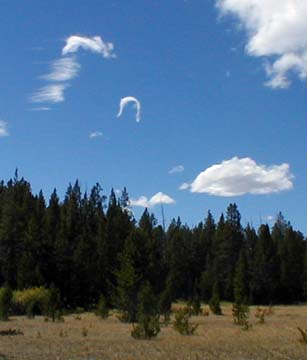
The cloud was near the trailhead. We repacked the truck and drove over dry roads to Pinedale Wyoming for a Laundromat and a fine steak dinner.